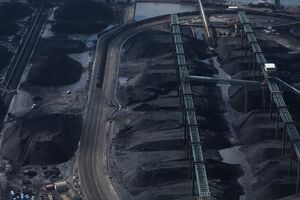Wet Dust Suppression
Water Suppression

Coal dust emissions in Southeast Newport News and Lambert's Point are primarily managed using wet suppression methods that consist of spraying water, or water with chemical additives, over coal storage piles, railcars, and/or transloading equipment using a system of sprinklers and water trucks. Water application is often adjusted based on terminal activity and ambient humidity conditions.
History in Hampton Roads
Water suppression is mentioned in the record as early as the 1920s, when the Chesapeake and Ohio (C&O) Railroad Company installed a custom pipe system to spray water on coal-filled railcars where and when the cars were emptied through overturning.[1] Following an air monitoring study in 1956 demonstrating coal was a major portion of airborne dust in Southeast Newport News and pressure from the Newport news City Council, C&O installed equipment to create a water fog over the coal piers to suppress dust.[2]
Following community pressure on politicians and complaints to Virginia Air Pollution Control Board and additional research in the 1980s, water suppression infrastructure was expanded in Southeast Newport News and Lambert's Point, Norfolk.[3] According to the Virginia Department of Environmental Quality (VA DEQ), the new water suppression system at the terminals in Southeast Newport News reduced coal dust emissions by 80%.[4]
Today
Despite decades of dust control using water suppression, nearby residents continue to report evidence that coal dust negatively impacts local air quality, outside and in their homes, leaves dust films on outdoor and indoor surfaces, harms quality of life, and requires residents and property owners to bear high air filtration costs.[3] That said, it is commonly held that coal dust pollution in Southeast Newport News was worse before the water suppression sprinkler system was upgraded in the 1980s.
The Dominion Terminal now used 79 sprinklers, turned on about four times per day or more depending on the weather, as well as a water truck dispatched to locations not covered by the sprinklers.[5] The Kinder Morgan Bulk Terminals use a system of 44 sprinklers to spray water that suppresses dust emissions from the piles and transloading equipment. In 2022, Kinder Morgan spokesperson Amy Baek claimed the Kinder Morgan Terminals used 20,000 gallons of water every hour to suppress dust emissions.[3]
Water suppression is argued to be effective at fairly low cost.[6] The terminals in Southeast Newport News and Lambert's Point have fought against other dust mitigation methods, not because they do not work, but because of their associated price tag,[7] even though costs are small as a fraction of the terminals' annual revenue.
Chemical Coatings
Many private companies offer chemical sprays that coat the coal, usually within the train car, with a sealant that prevents fugitive dust emissions.[8]
Documents
- Railroads of Port Adopt Coal Sprinkle: Growing demand for Sprinkled Coal Said to Be Made by Trans-Shippers, Daily Press, November 23, 1927
- Ohio Office of Air Pollution Control, Reasonably Available Control Measures for Fugitive Dust Sources (Part 1), September 1980
- Ohio Office of Air Pollution Control, Reasonably Available Control Measures for Fugitive Dust Sources (Part 2), September 1980
- Ohio Office of Air Pollution Control, Reasonably Available Control Measures for Fugitive Dust Sources (Part 3), September 1980
- Ohio Office of Air Pollution Control, Reasonably Available Control Measures for Fugitive Dust Sources (Part 4), September 1980
- Email Correspondence between Richard Posner of Dust Solutions, Inc. and Repair Lab Team Member, 2023
References
- ↑ Railroads of Port Adopt Coal Sprinkle: Growing demand for Sprinkled Coal Said to Be Made by Trans-Shippers, Daily Press, November 23, 1927.
- ↑ C&O to Install Costly Equipment for Control of Air Pollution in NN, Daily Press, December 12, 1956.
- ↑ 3.0 3.1 3.2 Vogelsong, Virginia Will Begin Monitoring Air Pollution around Hampton Roads Coal Terminals: Residents of Newport News’ East End Say There’s Been Too Many Studies and Too Little Action, Virginia Mercury, April 19, 2022.
- ↑ Seeking VA DEQ reference.
- ↑ Coal dust, piles an issue for southeast Newport News, Daily Press, July 2011, Updated: August 18, 2019.
- ↑ Ohio Office of Air Pollution Control, Reasonably Available Control Measures for Fugitive Dust Sources (Part 2), September 1980.
- ↑ Email Correspondence with Richard Posner, President of Dust Solutions Inc., 2023.
- ↑ Dust Solutions Inc., Rail Loading & Unloading, August, 7 2023.